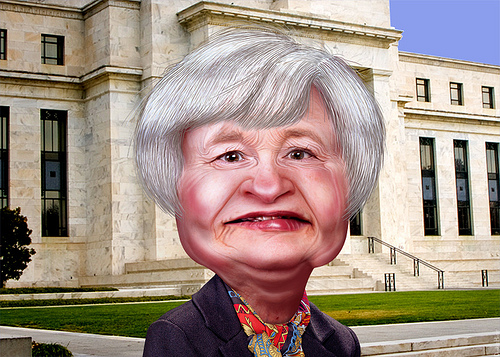That was quite an initiation for Janet Yellen. After delivering mostly-expected policy decisions (a further $10 billion reduction in bond buying and the addition of new, more qualitative measures to determine when the central would raise short-term interest rates), the newly minted Fed Chair conducted her first press conference. Stock and bond markets were already trading lower before the presser began, in response to Fed officials’ raising interest rate projections slightly—by the end of 2015, it is now expected that the fed funds rate would be 1 percent, up from the 0.75 percent projection made last December, and by the end of the following year, the rate would be 2.25 percent, up from 1.75 percent. Those may not seem like big increases, but they represent a sizable jump, when it comes to market expectations. Yellen tried to downplay the increases, warning against reading too much into the so-called "dot plot," (the prediction of the Fed Funds rate from each Fed Governor is plotted on a chart).
But the change in rate expectations was just a warm up for the larger jolt to markets. The accelerant to the selling came later during the press conference, when Yellen was asked how long after the end of bond buying might the central bank start raising rates. In an offhanded manor, she responded with eight words that shook up markets: “something on the order of around six months.”
SELL MORTIMER, SELL! Investors quickly did a little math: if bond buying ends in the fall, that means interest rates could rise in the spring of 2015, about 3 to 6 months earlier than generally anticipated. Those words pushed up rate expectations and walloped stock and bond prices within moments that Yellen uttered them.
It took investors all of 24 hours to realize that maybe not much had changed after all. The Fed’s path is dependent on incoming economic data and both the Fed statement and Yellen’s press conference indicated that the central bank is likely to move only gradually. Unless inflation starts rising precipitously, the Fed will continue to err on the side of easy monetary policy.
It also is interesting to note that the central bank is notoriously bad at making short-term predictions about the economy and even if they are right about rates raising a sooner than previously thought, wouldn’t that be good news? It would mean that the economy had improved enough to warrant the Fed’s removal of stimulus. That may not be great news for fast money investors, but for everyone else in the real word, an economy that is growing by more than 3 percent annually, which can create decent jobs and where all income levels can get a raise, sounds dreamy.
A word about those elusive wage increases. There have been some murmurs about wage growth finally accelerating this year. Currently wages are increasing by about 2 percent from a year ago, but only by 1.1 percent after adjusting for inflation. But wage growth has been concentrated on the upper end of the income spectrum, according to the OECD’s Society at a Glance report, a data-driven barometer of the economic and social health of its 34 member countries. The report found that in the US, the share of pre-tax income going to the top 1 percent of earners continues to be the highest among OECD countries, standing at 19.3 percent in 2012, more than double the level in 1980.
As noted in House of Debt, real income for the median U.S. family doubled from 1947 to 1980, when the rising tide of productivity lifted all boats. However, “while the United States is producing twice as much per hour of work today compared to 1980, a small part of the gain in real income has gone to the bottom half of the income distribution,” as the share of profits has risen faster than wages and the highest paid workers are getting a bigger share of the wages that go to labor.
MARKETS: Despite the mid-week, Fed-induced sell-off, stock indexes finished higher over the five trading sessions.
- DJIA: 16,302, up 1.5% on week, down 1.6% YTD
- S&P 500: 1866, up 1.4% on week, up 1% YTD
- NASDAQ: 4276, up 0.7% on week, up 2.4% YTD
- 10-Year Treasury yield: 2.75% (from 2.65% a week ago)
- April Crude Oil: $99.46, up 0.9% on week
- April Gold: 1336, down 3.1% on week
- AAA Nat'l average price for gallon of regular Gas: $3.52 (from $3.69 a year ago)
THE WEEK AHEAD: As the second half of monthly housing data is released (new home sales and the Case Shiller price index), the biggest risk facing the market is that higher mortgage rates and tight credit conditions will sideline first time homebuyers. In order for the next leg of the housing recovery to take hold, these buyers must take the place of investors and cash buyers, who are likely to peter out.
Mon 3/24:
8:30 Chicago Fed National Activity Index
Tues 3/25:
9:00 Case-Schiller Home Price Index
10:00 Consumer Confidence
10:00 New Home Sales
Weds 3/26:
8:30 Durable Goods Orders
Thurs 3/27:
8:30 Weekly Jobless Claims
8:30 Q4 GDP (final estimate)
8:30 Corporate Profits
10:00 Pending Home Sales
Fri 3/28:
8:30 Personal Income and Spending
9:55 Consumer Sentiment
![Jill on Money [ Archive]](http://images.squarespace-cdn.com/content/v1/59efbd48d7bdce7ee2a7d0c4/1510342916024-TI455WZNZ88VUH2XYCA6/JOM+Blue+and+White.png?format=1500w)

